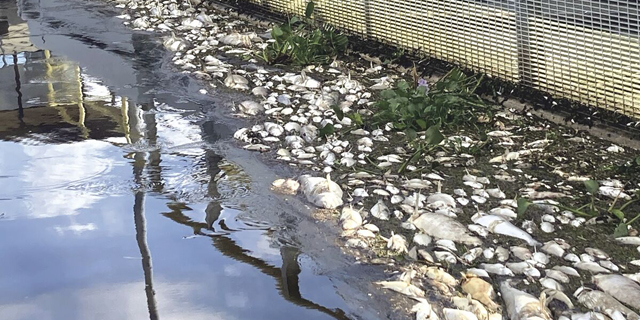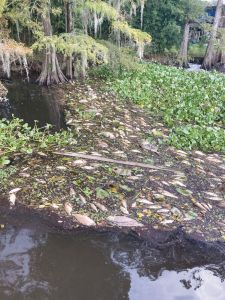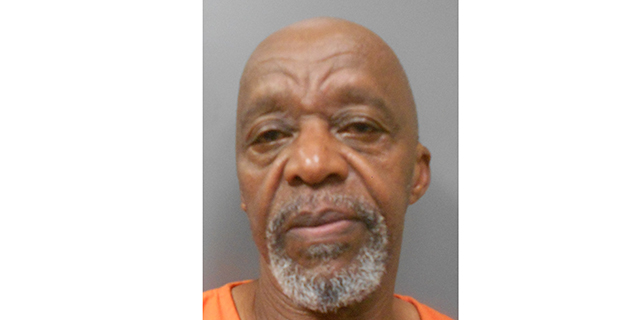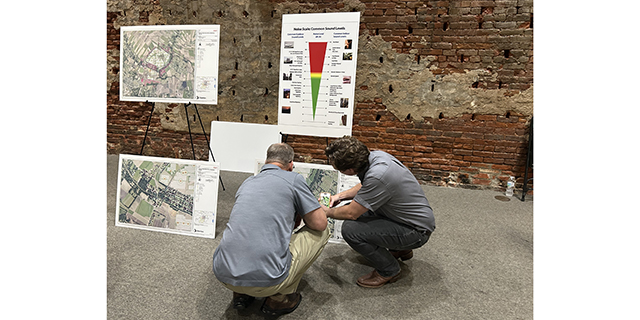Scattered fish kills post-Francine cover 2 million acres across coast
Published 1:38 pm Wednesday, September 25, 2024

- These fish died in the Belle River area in the aftermath of Hurricane Francine. Four Louisiana Department of Wildlife and Fisheries crews canvassed the waters to determine the scope of the hurricane-caused fish kill as part of the department's fish kill response program directed by the LDWF Inland Fisheries Division technical advisor, Robby Maxwell. www.wlf.louisiana.gov
Louisiana Department of Wildlife and Fisheries biologists have been monitoring fish kills across most of Louisiana’s Gulf Coast since Hurricane Francine came in in south central Louisiana.
There is plenty of concern among outdoorsmen, which is understandable, because the freshwater fisheries was impacted severely in the hurricane’s wake. A major high school bass tournament circuit recognized the magnitude of the situation and postponed its first tournament of 2024-25 originally scheduled for this past weekend.
Robby Maxwell, an inland fisheries technical advisor who also coordinates fish kill response from his District 5 office in Lake Charles, provided an update Sept. 24 on the hurricane’s aftermath that has alarmed fishermen in the Sportsman’s Paradise.
Hurricane Francine, which made landfall two weeks ago today, definitely harmed the fisheries. Bass, sac-a-lait, bream, shad, catfish, gar, choupique, even flounder, and other species went belly up because of hypoxic water conditions (low or depleted oxygen levels) that suffocated them, according to Maxwell.
However, it has been confirmed there wasn’t a total loss of fish or oxygen in waters across the four coastal districts hit by Hurricane Francine, Maxwell said, referring to LDWF’s District 6, which includes parts of Iberia as well as St. Martin and St. Mary parishes, District 9, District 7 and District 8. LDWF staffers on site and boaters on the water saw fish “piping” among the floating carcasses.
“We’re actually seeing oxygenated water” in many of the areas with dead fish, the 14-year veteran fisheries biologist and Texas State graduate said.
Fish kills started a few days after Hurricane Francine’s landfall Sept. 11 in Terrebonne Parish. The numbers started “ramping up” within a week.
Maxwell said there have been scattered fish kills covering approximately 2 million acres because of low oxygen levels from just west of the Atchafalaya Basin Protection Levee near Franklin north to the Lake Maurepas drainage. The affected areas included Luling and LaRose.
The Lake Verret and Belle River areas apparently experienced some of the worst fish kills. Dead fish first start showing up in canals around Lake Verret, the biologist said.
“If you look at it, all this area is where there was either hurricane force or strong gale winds,” he said, noting if you draw a line the impacted area basically follows the path of Hurricane Francine.
There have been very few reports of fish kills inside the Atchafalaya Basin. The most recent report from reliable local outdoorsmen indicates there was a sizeable fish kill in Bayou Boutte in the lower Spillway and a smaller one in Charenton Lake in St. Mary Parish.
Maxwell said the lower end of the Bayou Teche and Franklin Canal also had some fish kills.
Compared to concentrated, extensive fish kills following Hurricane Ida that pummeled southeast Louisiana in August 2021, post-Hurricane Francine’s fish kills appear to be less severe. And three years later, the fisheries is making a strong comeback in those waters once whipped up by Hurricane Ida, Maxwell said.
“We’ve been seeing good recovery since Ida. I don’t think the impact (from Hurricane Francine) will set it back as much as Ida did,” he said.
Four LDWF crews, one to three staffers each, are searching south central and southeast Louisiana waterways to determine the scope of fish kills. They have been working in the summer heat and stench of decaying fish and oxygen-less bad water in many areas.
“I am so proud of the crews that went out there,” Maxwell said.
There are no plans currently for stocking the affected waters and it’ll be a wait and see approach if there are any size restrictions placed on gamefish in the future, according to Maxwell. It’s up for discussion at a later date, he said, whenever all the data is in.
“We’ll have to see how it settles out before making a management decision,” he said, pointing out Inland Fisheries Division administrators and district fisheries biologists who know their respective areas the best will decide.
“Yeah, we’ll have discussions,” he said.
Tommy Abbott, Louisiana High School B.A.S.S. Nation director, broke the news about the fish kill-induced postponement early on a Thursday, two days before the first tournament of the season was scheduled to be held Sept. 21 out of Doiron’s Landing, Stephensville. During a Facebook podcast, Abbott said he had a sleepless night before making the decision based on people he trusted as advisors, including Cliff “Cajun Baby” Crochet of Pierre Part, pro bass angler and founder of the Every Fish Matters stocking effort on both the Stephensville side and in the Spillway.
LHSBN plans to reschedule the East Division tournament, according to Abbott. Whether it returns to Doiron’s Landing this fall or next spring is up in the air.

A fish kill was evident along the Amite River following the passage of Hurricane Francine after it made landfall Sept. 11 approximately 30 miles from Morgan City. Robby Maxwell, LDWF Inland Fisheries technical advisor coordinating the state agency’s fish kill response, said there are scattered fish kills across about 2 million acres in south central and southeast Louisiana.
www.wlf.louisiana.gov





